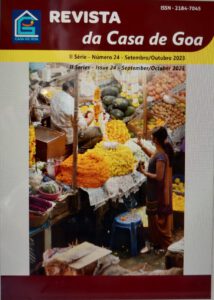Editorial

We are holding in our hands an edition tracing the journey of the Konkani and Portuguese languages in Goa; Luso-tropical drama; fiction and travel literature; cuisine; the arts and artists; fragments of our history and culture; and what matters most, reminding us of our duty to be defenders of all that comprises the idea and spirit of Goa.
This issue opens with an essay bearing a poetic title and interesting content: “Portuguese in different sounds”, by our associate editor José Filipe Monteiro. Elsewhere, he reviews O Signo da Ira (The Sign of Wrath), a neorealist novel by Orlando Costa, one of the classics of Indo-Portuguese literature, set in Goa of the nineteen sixties. Costa is also remembered in Júlia Serra’s feature article bearing the title of his play Sem Flores nem Coroas (No Flowers, No Wreathes).
It is well known that Portuguese and Konkani mutually enriched each other in Goa. Less known, however, is the tale of two Indian sisters – Konkani and Marathi – that clashed. A learned Goan resident in Lisbon it was who stopped the conflict dead in its tracks, as associate editor Óscar de Noronha narrates in his essay titled “Dalgado and the Konkani-Marathi controversy”.
We take this opportunity to launch a new section, Document, presenting in English translation the first of the nine articles, under the title “Konkani is not a dialect of Marathi”, published over a century ago in Panjim’s Heraldo, by Monsignor Sebastião Rodolfo Dalgado. There he proved the linguistic and grammatical characteristics of Konkani, and established its identity.
We can feel the sweetness of a language in its popular literature, as illustrated by our Konkani Corner, where you can revisit Konkani sayings translated into Portuguese by the late poet Barreto Miranda. Gastronomy too has the ability to lighten the atmosphere; so, it is no surprise that José Filipe Monteiro has paid tribute to Agnelo Silveira, missing as he does the “man who set up Goan cuisine in Lisbon”.
Ana de Miranda writes about some other aspect of the “mythical, legendary East”. In her very suggestive text, titled “Monsoon Funeral”, she sketches her family history; of how “little by little, slowly and elegantly, the occupant of the house bids goodbye and lets himself dissolve in the rainwater”: a tribute to artist Rishaad de Miranda, son of the great caricaturist Mário, whom we paid homage earlier (Revista da Casa de Goa, No. 12).
“All the world’s a stage, and all the men and women merely players” is a short and sweet Shakespearean line that must have been at the back of Joaquim Correia’s mind when he wrote “Theatre in Goa: tradition and its similarities with Macau and Portugal”: a survey of the traditional Konkani tiatr in Goa, placed parallel to Macanese patois theatre and the Portuguese Teatro de Revista.
And speaking of the Far East, António Aresta travels “From India to Macau”, following the itinerary of the nineteenth-century traveller Pedro Gastão Mesnier, who was also a public works conductor and professor of physics and chemistry in Goa, and later, private secretary to the Governor of Macau, and editor and teacher there.
Such a fascinating life that; or as Amanda D’Costa says in her poem, speaking of another “man with a dream”: “It’s worth it”! The same can be said about the painting by Clarice Vaz, our resident collaborator; a watercolour by Girish Gujar, and photography by Payal Kakkar. Of course, all three refer to Goa, a land that is Susegad (Quiet), as was evident from an exhibition of the same name, comprising painting and associated cultural programme, coordinated by João Coutinho, a member of Casa de Goa. Interestingly, a weekly newsmagazine in video format, produced in Konkani by the Goan diasporic community of Melbourne, is titled similarly: Susegad Danpaar (Quiet Afternoon). These two news items comprise the respective section of our Revista.
Of course, our edition is never complete without reflecting on our culture. Thus, readers will have the opportunity to read the third part of the article co-authored by Philomena and Gilbert Lawrence, on the topic: “Is GEM culture (Goan, East Indian and Mangalorean) a victim of academic baloney?” Very important to enlighten the new generations and make sure that they do not give in to ill-informed clichés about the Indo-Portuguese way of life.
But what was life in Goa really like? In his series on “Fragments of Goan History”, Mário Viegas profiles the Regional Centre of Chinchinim, an association located in that illustrious village of Salcete and active in the last century.
Who can resurrect the ancient guardians of our modus vivendi? In fact, it is more important to find new ones, because without them, Goa will be nothing, and “will end by itself”, going by a rather portentous dictum attributed to St Francis Xavier. And three quarters of a century ago, what were those “Defenders of the Portuguese Flag in Bombay” targeting? They are mysteries that John Menezes unveils in his well-documented article dotted with precious autobiographical snippets.
We are very fortunate to be part of the Revista, which also strives to be a guardian of Indo-Portuguese culture. Hopefully, it will always be welcomed by the powers-that-be and by the world at large.
(Revista da Casa de Goa, Series II, No. 24, September-October 2023)